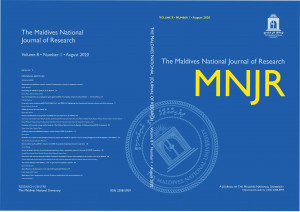Nowcasting the COVID‑19 epidemic in the Maldives
DOI:
https://doi.org/10.62338/vgdj9q26Keywords:
COVID‑19, Mathmetical Modeling, Maldives, epidemic progression, SIRDAbstract
The novelty of COVID‑19 prompted reliance on mathematical modelling to guide decision making and planning pandemic response. The compartment model using suspected, infected recovered and death (SIRD) as used in the Maldives to forecast the epidemic which was nowcasted (adjusted in real‑time) to produce parameters on epidemic progression in the Male’ area to allow for quick decision making. Deriving the model input parameters were challenging and introduced a greater level of uncertainty in model output parameters. Recognition of the data limitation in presenting model outputs allowed for quick decision making in the COVID‑19 early phase towards control of the epidemic.
References
Anastassopoulou, C., Russo, L., Tsakris, A., & Siettos, C. (2020). Data‑based analysis, modelling and forecasting of the COVID‑19 outbreak. PloS one, 15(3), e0230405.
Anderson, R. M., Heesterbeek, H., Klinkenberg, D., & Hollingsworth, T. D. (2020). How will country‑based mitigation measures influence the course of the COVID‑19 epidemic?. The Lancet, 395(10228), 931‑934.
Brauer, F. (2008). Compartmental models in epidemiology. In Mathematical epidemiology (pp. 19‑79). Springer, Berlin, Heidelberg.
Capaldi, A., Behrend, S., Berman, B., Smith, J., Wright, J., & Lloyd, A. L. (2012). Parameter estimation and uncertainty quantication for an epidemic model. Mathematical biosciences and engineering, 553.
Cheng, H. Y., Jian, S. W., Liu, D. P., Ng, T. C., Huang, W. T., & Lin, H. H. (2020). High transmissibility of COVID‑19 near symptom onset. medRxiv.
Christley, R. M., Mort, M., Wynne, B., Wastling, J. M., Heathwaite, A. L., Pickup, R., & Latham, S. M. (2013). “Wrong, but useful”: negotiating uncertainty in infectious disease modelling. PLoS One, 8(10).
Clémençon, S., Chi Tran, V., & de Arazoza, H. (2008). A stochastic SIR model with contact‑tracing: large population limits and statistical inference. Journal of Biological Dynamics, 2(4), 392‑414. doi:10.1080/17513750801993266.
Dehning, J., Zierenberg, J., Spitzner, F. P., Wibral, M., Neto, J. P., Wilczek, M., &Priesemann, V. (2020). Inferring COVID‑19 spreading rates and potential change points for case number forecasts. arXiv preprint arXiv:2004.01105.
Desai, A. N., Kraemer, M. U., Bhatia, S., Cori, A., Nouvellet, P., Herringer, M., & Lassmann, B. (2019). Real‑time Epidemic Forecasting: Challenges and Opportunities. Health Security, 17(4), 268‑275.
Ferguson, N., Laydon, D., Nedjati Gilani, G., Imai, N., Ainslie, K., Baguelin, M., & Dighe, A. (2020). Report 9: Impact of non‑pharmaceutical interventions (NPIs) to reduce COVID‑19 mortality and healthcare demand.
Flaxman S, Mishra S, Gandy A, Unwin H, Coupland H, Mellan T, Zhu H, Berah T, Eaton J, Perez Guzman P, Schmit N (2020). Report 13: Estimating the number of infections and the impact of non‑pharmaceutical interventions on COVID‑19 in 11 European countries.
Hauser, A., Counotte, M. J., Margossian, C. C., Konstantinoudis, G., Low, N., Althaus, C. L., &Riou, J. (2020). Estimation of SARS‑CoV‑2 mortality during the early stages of an epidemic: a modelling study in Hubei, China and northern Italy. medRxiv.
Getz, W. M., Salter, R., & Mgbara, W. (2019). Adequacy of SEIR models when epidemics have spatial structure: Ebola in Sierra Leone. Philosophical Transactions of the Royal Society B: Biological Sciences, 374(1775), 1‑7. doi:10.1098/rstb.2018.0282
Höhle, M., & Feldmann, U. (2007). RLadyBug—An R package for stochastic epidemic models. Computational Statistics & Data Analysis, 52(2), 680‑686. doi:10.1016/j.csda.2006.11.016Nowcasting the COVID‑19 epidemic in the Maldives.
Hyuk‑Jun, C., & Chang, H.‑J. (2017). Estimation of basic reproduction number of the Middle East respiratory syndrome coronavirus (MERS‑CoV) during the outbreak in South Korea, 2015. BioMedical Engineering OnLine, 16, 1‑11. doi:10.1186/s12938‑017‑0370‑7
Kermack, W. O., McKendrick, A. G A., (1927). Containing papers of a mathematical, & character. A contribution to the mathematical theory of epidemics. JPOTRSLS 115(772), 700‑721.
Lauer, S. A., Grantz, K. H., Bi, Q., Jones, F. K., Zheng, Q., Meredith, H. R., & Lessler, J. (2020). The incubation period of coronavirus disease 2019 (COVID‑19) from publicly reported confirmed cases: estimation and application. Annals of internal medicine, 172(9), 577‑582.
Li, R., Lu, W., Yang, X., Feng, P., Muqimova, O., Chen, X., & Wei, G. (2020). Prediction of the Epidemic of COVID‑19 Based on Quarantined Surveillance in China.
Lin, F., Muthuraman, K., & Lawley, M. (2010). An optimal control theory approach to non‑pharmaceutical interventions. BMC infectious diseases, 10(1), 32.
Lipsitch, M., Finelli, L., Heffernan, R. T., Leung, G. M., & Redd; for the 2009 H1N1 Surveillance Group, S. C. (2011). Improving the evidence base for decision making during a pandemic: the example of 2009 influenza A/H1N1. Biosecurity and bioterrorism: Biodefense Strategy, Practice, And Science, 9(2), 89‑115.
Magnus, M. (2012). Essential readings in infectious disease epidemiology. Jones & Bartlett Publishers.
Ministy of Health (2020). COVID‑19 local updates. Accessed 2 May 2020, https://COVID‑19.health.gov.mv/en/
National Bureau of Statistics (2018) Statistical Yearbook of Maldives 2018. Author: Male’, Maldives.
Osemwinyen, A., & Diakhaby, A. (2015). Mathematical Modelling of the Transmission Dynamics of Ebola Virus. Applied and Computational Mathematics (New York), 4, 313‑320. doi:10.11648/j.acm.20150404.19
Pellis, L., Ferguson, N., & Fraser, C. (2011). Epidemic growth rate and household reproduction number in communities of households, schools and workplaces. Journal of Mathematical Biology, 63(4), 691‑734. doi:10.1007/s00285‑010‑0386‑0
Tuen Wai, N., Turinici, G., & Danchin, A. (2003). A double epidemic model for the SARS propagation. BMC Infectious Diseases, 3(1), 19‑16. doi:10.1186/1471‑2334‑3‑19
Verity, R., Okell, L. C., Dorigatti, I., Winskill, P., Whittaker, C., Imai, N., ... &Dighe, A. (2020). Estimates of the severity of coronavirus disease 2019: a model‑based analysis. The Lancet infectious diseases.
Wu, J. T., Leung, K., & Leung, G. M. (2020). Nowcasting and forecasting the potential domestic and international spread of the 2019‑nCoV outbreak originating in Wuhan, China: a modelling study. The Lancet, 395(10225), 689‑697
Wu, Z., & McGoogan, J. M. (2020). Characteristics of and important lessons from the coronavirus disease 2019 (COVID‑19) outbreak in China: summary of a report of 72 314 cases from the Chinese Centre for Disease Control and Prevention. Jama, 323(13), 1239‑1242.Nowcasting the COVID‑19 epidemic in the Maldives



